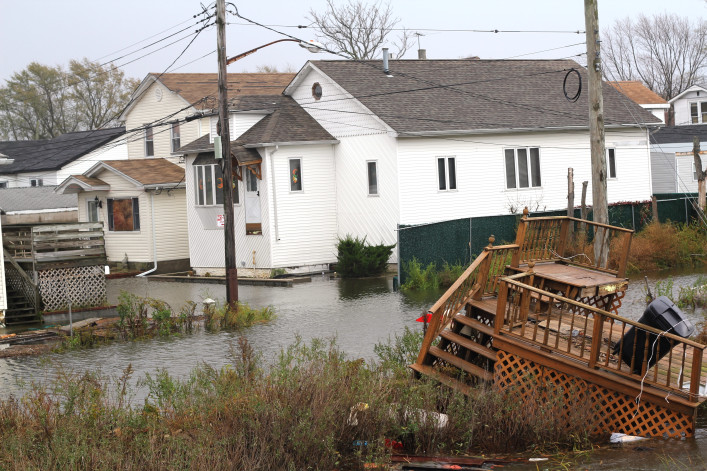What goes into lifting a house, and who should do it?

Howard Beach in the aftermath of Hurricane Sandy. Pamela Andrade
Superstorm Sandy's floodwaters devastated coastal neighborhoods of New York City, Long Island, and New Jersey in 2012, a nasty surprise in its destructiveness. The extent of its damage was due to a confluence of factors, including high tides and an atypical trajectory.
According to the Huffington Post, Sandy cost NYC an estimated $19 billion dollars in public, private, and indirect costs, so despite the storm's rarity, many home and business owners have taken steps to prevent similar losses in the future. One method of defense against potential damage: elevating your home so that you're protected from flooding, a time-consuming and costly endeavor, but one that could ultimately save your house, along with all your belongings.
It's also one many homeowners were compelled to undertake post-Sandy. Garrett Guttenberg, executive vice president at the Denis A. Miller Insurance Agency, the largest flood insurance agency on Long Island, has hundreds of clients who have raised their houses. He says that for many homeowners in Sandy-devastated neighborhoods, their flood insurance would have skyrocketed if they hadn't done so.
Who should lift their house?
In Long Beach, a city on Long Island especially hard hit by the storm, some residents saw their homes damaged by two disasters—Hurricane Irene and Superstorm Sandy. Guttenberg says the owners of these houses were warned that FEMA wouldn't be paying flood insurance claims anymore unless they were raised.
FEMA determines to which point these homeowners should elevate their homes by calculating the base flood elevation (BFE)—that is, the base line where a flood would hit during a superstorm. (The agency offers a lookup service here to determine what your BFE is by address.) In Long Beach, says Guttenberg, homeowners should not have a liveable space two feet below the BFE, and most homes are raised four feet above the line.
After the storm, FEMA representatives walked around Long Beach and marked properties that were damaged, Guttenberg explains. Then they determined, based on the extent of the damage, whether it was most cost-effective to demolish a house, raise it, or conduct smaller-scale renovations.
New York Rising, a project of the Governer's Office of Storm Recovery, has been providing homeowners with the funds needed to elevate, which Guttenberg estimates could run between $80,000 to $150,000. According to ImproveNet, costs vary based on a number of factors, including home size, the extent of flood damage, the stability of your foundation, and the permits your area requires.
In NYC, 15 communities are receiving New York Rising support, including lower Manhattan, Red Hook, Howard Beach, Staten Island, and the East Bronx waterfront. The funding goes not only toward helping individual homeowners, but also implementing to other strategies for better storm protection.
New York Rising's standards dictate that if your home is located within a 100-year flood plain—which means there's a one percent probability that a flood will occur in any given year—and your home sustained damage equal to, or greater than, 50 percent of its pre-storm market value, then you're eligible for some financial assistance.
"It makes so much sense [for these homeowners to lift]," Guttenberg says. "Otherwise, they'll end up paying $4,000 a year in flood insurance. Over 20 years, that's close to $100,000. Meanwhile, they don't even have to lay out the cost of raising a house, and the value of the house is going to go up. There's no downside, other than you have to be out of the house."
The nitty-gritty of lifting a home
Expect a "slow and tedious process," says Larry Ubell, a licensed New York and New Jersey home inspector. (FEMA breaks down in detail the different possible approaches to elevating homes here.)
Ubell explains that the entire home must be lifted evenly; typically, steel girders go under the property to push it upward. "You create a big tic-tac-toe board with cables and hydraulics," Ubell says. "They lift up the whole building and build a new foundation under it, then lower it into a steel structure."
Guttenberg adds that for a while, the home will be suspended in the air while a new foundation is constructed beneath it. "That takes at least a month, and the entire process will take months to a year, depending on how quick they're working," he says.
Post-elevation, the house is effectively on stilts. Beneath it, some owners create a carport unit with breakaway walls, so if it floods, the building itself isn't impacted.
"The foundation is usually open, or they put flood vents in so water can pass through," Guttenberg says. "The first floor will never get hit."
However, for some unfortunate homeowners, the process isn't smooth. Last spring, ABC reported on one house in Babylon, Long Island that fell off its risers after being elevated for Sandy repairs.
Making sure that the company handling the elevation is experienced and well-insured is key, Ubell says: "You have to look at the reputation of the person doing it and their insurance coverage. If one thing goes, the whole building crumbles to pieces right there." ImproveNet's guide advises that your house lifting company have liability insurance with coverage of at least $200,000.
But Jeffrey Schneider of Gotham Brokerage (fyi, a Brick sponsor) says that the contractor's coverage should at least exceed the value of your home—and in the NYC area, that's likely to be well above $200,000.
Guttenberg acknowledges that in places like Long Beach, lifting houses was definitely a learning process for everyone. But at the end of the day, it worked out. "Everyone complained, but now that it's done, they're happy," he says.
Other storm protections in NYC
Homeowners have to relocate while their houses are being lifted; Guttenberg says that typically they will have to take on the cost of a short-term rental themselves. While the renovation is underway, he adds, "standard homeowners policies must be cancelled and replacement with 'vacant under renovation' policies. These policies are two to three times more expensive than the traditional homeowners insurance, as the risk is greater with a vacant home and workers all over the place."
A home is considered vacant when owners have removed personal property and shut off the utilities, which would apply in most elevations. Unoccupied homes are considered to be at higher risk for break-ins, vandalism, and weather-related damage, Insurance.com explains, and will typically require a separate--and pricier--insurance policy.
Homeowners also need to decide whether to empty their houses of all belongings. If they opt to leave things in place, Guttenberg says, they'll be added to the renovation policy under builders' risk insurance; if they move everything to a short-term rental, they can opt for renters insurance.
For large apartment towers along the NYC waterfront, elevation seems an unlikely prospect. However, most climate scientists agree that New York stands to be seriously impacted by rising waters in the coming years. New York reports that today's NYC kid could see local waterways rise by as much as six feet in their lifetime—so one way or another, building landlords and homeowners here need to brace for floods.
One not-so-painful fix, Ubell says, is for the owners of multi-tenant properties to relocate important building infrastructure to a higher floor.
"In the parts of Brooklyn and Manhattan devastated by Sandy, the heating system and electrical panels were the biggest things damaged. Then a lot of owners replaced them with the exatly the same system in the same location," Ubell says. "Steam heating systems have to be in the basement or cellar, but if you have a hot water system, you can put the boiler anywhere you want."
The developers of the new American Copper luxury towers along the East River seem to agree with Ubell: The New York Times writes that the property includes electrical equipment and five emergncy generators on the 48th floor, so that tenants have power no matter how severely the buildings are flooded. "Resilient design," the article notes, has become an increasingly popular concept among builders, as they weigh how climate change might impact developments.
But if you own your own home and are in a flood zone, you should seriously consider elevating it, Ubell says, even if you missed the deadline to apply for New York Rising support. "You're over a barrel," he says. "Take out a short-term loan to do the work."
You Might Also Like

























